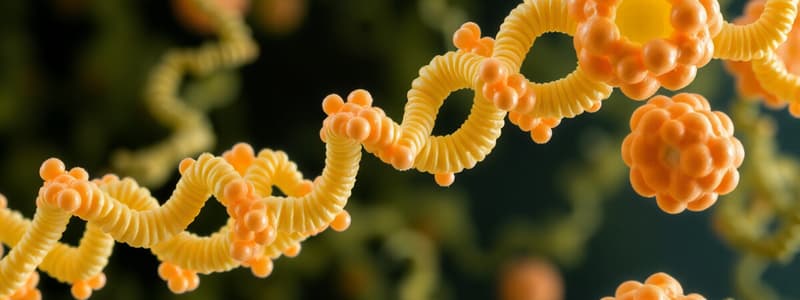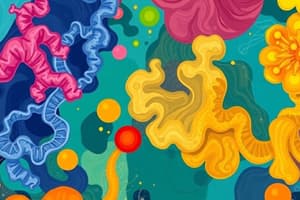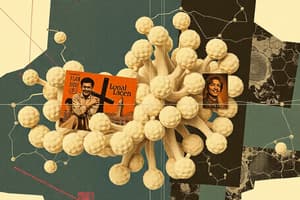Podcast
Questions and Answers
What is the primary function of fibrous proteins?
What is the primary function of fibrous proteins?
- Regulate growth and development
- Transport molecules and immune defense
- Provide mechanical support and tensile strength (correct)
- Lower the activation energy of chemical reactions
Which statement about enzymes is true?
Which statement about enzymes is true?
- Enzymes lower the activation energy of chemical reactions. (correct)
- Enzymes increase the activation energy required for reactions.
- Enzymes are not necessary for biological reactions to occur.
- Enzymes can only catalyze a single type of reaction.
How is ATP primarily utilized by the body?
How is ATP primarily utilized by the body?
- As the main energy storage molecule.
- As a structural component in cell membranes.
- To act as a transport molecule.
- To transfer energy for cellular work. (correct)
What happens to a molecule when it receives a phosphate group from ATP?
What happens to a molecule when it receives a phosphate group from ATP?
Which characteristic is typical of globular proteins?
Which characteristic is typical of globular proteins?
What primarily governs the structure of the plasma membrane?
What primarily governs the structure of the plasma membrane?
What is the role of cholesterol in the plasma membrane?
What is the role of cholesterol in the plasma membrane?
Which type of membrane protein spans the entire width of the plasma membrane?
Which type of membrane protein spans the entire width of the plasma membrane?
What is the main function of receptor proteins in the plasma membrane?
What is the main function of receptor proteins in the plasma membrane?
What characterizes tight junctions between cells?
What characterizes tight junctions between cells?
How do carbohydrates contribute to the cell membrane?
How do carbohydrates contribute to the cell membrane?
Which type of protein is primarily involved in cell-cell recognition?
Which type of protein is primarily involved in cell-cell recognition?
What is a key function of transport proteins in the cell membrane?
What is a key function of transport proteins in the cell membrane?
What type of movement do carrier proteins typically enable?
What type of movement do carrier proteins typically enable?
Which feature of phospholipids contributes to the membrane's ability to reseal when damaged?
Which feature of phospholipids contributes to the membrane's ability to reseal when damaged?
Which of the following is not a major function of membrane proteins?
Which of the following is not a major function of membrane proteins?
The extracellular surface of membranes is often characterized by what feature?
The extracellular surface of membranes is often characterized by what feature?
Which protein form functions primarily to maintain cell shape?
Which protein form functions primarily to maintain cell shape?
What is the function of intercellular junctions?
What is the function of intercellular junctions?
What is the main function of receptor-mediated endocytosis?
What is the main function of receptor-mediated endocytosis?
Which of the following best describes exocytosis?
Which of the following best describes exocytosis?
What key role do potassium ions (K+) play in maintaining the resting membrane potential?
What key role do potassium ions (K+) play in maintaining the resting membrane potential?
What is a defining characteristic of nervous tissue?
What is a defining characteristic of nervous tissue?
What type of tissue is primarily responsible for movement in the body?
What type of tissue is primarily responsible for movement in the body?
Which process maintains the electrochemical gradients in cells?
Which process maintains the electrochemical gradients in cells?
What characterizes covering epithelium?
What characterizes covering epithelium?
Which type of muscle tissue is found in the heart and is under involuntary control?
Which type of muscle tissue is found in the heart and is under involuntary control?
What is the average resting membrane potential of a cell?
What is the average resting membrane potential of a cell?
Which function is NOT associated with epithelial tissue?
Which function is NOT associated with epithelial tissue?
In what manner do supporting cells in nervous tissue function?
In what manner do supporting cells in nervous tissue function?
What happens during transcytosis?
What happens during transcytosis?
What type of signaling is essential for normal growth and immunity?
What type of signaling is essential for normal growth and immunity?
Which type of muscle tissue contracts to move substances through hollow organs?
Which type of muscle tissue contracts to move substances through hollow organs?
What type of burn is characterized by redness and pain without breaking the skin?
What type of burn is characterized by redness and pain without breaking the skin?
What is a common consequence of a 3rd degree burn?
What is a common consequence of a 3rd degree burn?
Which of the following is NOT a function of bones?
Which of the following is NOT a function of bones?
What is the primary characteristic of fibrocartilage?
What is the primary characteristic of fibrocartilage?
Which function of bones is related to the storage of fat?
Which function of bones is related to the storage of fat?
What is the main outcome of osteocalcin production?
What is the main outcome of osteocalcin production?
What type of growth involves the laying down of new cartilage on the surface of existing cartilage?
What type of growth involves the laying down of new cartilage on the surface of existing cartilage?
Which type of cartilage is most abundant and found at the ends of long bones?
Which type of cartilage is most abundant and found at the ends of long bones?
What type of burn involves fluid-filled blisters and requires more time for healing?
What type of burn involves fluid-filled blisters and requires more time for healing?
Which statement is true regarding the critical nature of burns?
Which statement is true regarding the critical nature of burns?
What is the primary function of the arrector pili muscle?
What is the primary function of the arrector pili muscle?
Which layer of hair is responsible for its toughness?
Which layer of hair is responsible for its toughness?
What determines the color of hair?
What determines the color of hair?
What distinguishes terminal hair from vellus hair?
What distinguishes terminal hair from vellus hair?
What is a likely characteristic of gray or white hair?
What is a likely characteristic of gray or white hair?
Which component of the hair follicle provides sensation?
Which component of the hair follicle provides sensation?
What occurs during the resting phase of hair growth?
What occurs during the resting phase of hair growth?
Which type of hair is predominantly found in infants and children?
Which type of hair is predominantly found in infants and children?
How is true baldness typically influenced?
How is true baldness typically influenced?
What type of cells are responsible for contracting sweat glands?
What type of cells are responsible for contracting sweat glands?
What is the outermost layer of hair composed of?
What is the outermost layer of hair composed of?
What role does the dermal papilla serve in the hair follicle?
What role does the dermal papilla serve in the hair follicle?
What is the function of nails?
What is the function of nails?
In which conditions would argyria occur?
In which conditions would argyria occur?
Flashcards are hidden until you start studying
Study Notes
Protein Types
- Fibrous Proteins: Long strands providing mechanical support and tensile strength; can contract and return to original length. Examples: collagen and muscle proteins.
- Globular Proteins: Compact and spherical; biologically active, involved in transporting molecules, immune responses, and regulating growth and development.
- Enzymes: Biological catalysts that lower activation energy for reactions; can be highly specific or act on multiple substrates; crucial for sustaining biological processes.
ATP & Cellular Energy
- Adenosine Triphosphate (ATP): Primary energy-transfer molecule in cells; oxygen is required for ATP production.
- Triphosphate Tail: Contains high-energy bonds; transferring a phosphate group to another molecule grants it temporary energy, which is lost once work is done.
- Energy Dynamics: ATP storage and release are essential for driving chemical reactions in cells, highlighting the transient nature of ATP.
Plasma Membrane Structure
- Fluid Mosaic Model: Describes the plasma membrane as a phospholipid bilayer with randomly dispersed proteins, which is mainly impermeable to water-soluble molecules.
- Functions: Separates intracellular fluid (ICF) from extracellular fluid (ECF).
Chemical Composition of Cell Membranes
-
Lipids:
- Phospholipids: Form the membrane's foundation; features hydrophilic phosphate heads and hydrophobic fatty acid tails, crucial for membrane resealing.
- Cholesterol: Stabilizes the membrane structure while maintaining flexibility.
-
Proteins:
- Integral proteins span the membrane; major roles include transport, enzyme functions, and cell recognition.
- Peripheral proteins are loosely attached and largely serve as enzymes and structural components.
-
Carbohydrates: Coat the extracellular surface, forming glycocalyx; involved in cell recognition and tissue identification.
Cell Junctions
- Function: Connect or adhere cells together.
- Types of Junctions:
- Tight Junctions: Seal adjacent cells, maintaining the environment balance and communication.
- Receptor-Mediated Endocytosis: Specific intake of substances through receptor binding.
- Exocytosis: Process of transporting substances out of the cell through vesicles.
- Transcytosis: Movement into, across, and out of a cell, facilitating transport through tissues.
- Vesicular Trafficking: Transfers substances within the cell without leaving it.
Membrane Potential
- Resting Membrane Potential: Average of -70 mV; characterized by a charge difference across the membrane, with a more negative inside.
- Ion Balance: High concentration of Na+ outside and K+ inside; K+ channels are leakier, influencing membrane potential.
- Active Transport: Maintains ion gradients, ensuring the cell's resting potential is stable amidst Na+ leakage.
Plasma Membrane Receptors
- Role: Enable cell-environment interactions through ligand binding.
- Contact Signaling: Cells recognize each other through physical contact; significant for growth and immunity.
- Chemical Signaling: Ligands bind to receptors, triggering intracellular responses; one ligand can result in multiple cellular changes.
Tissues Overview
- Definition: Groups of similar cells performing common functions; essential for organ complexity and function.
- Types of Tissue:
- Nervous: Control functions, encompassing neurons and supportive cells.
- Muscle: Facilitates movement; consists of skeletal, cardiac, and smooth muscle types.
- Epithelial: Forms coverings and lines cavities; can be covering or glandular epithelium.
- Connective: Provides structural support.
Nervous Tissue
- Function: Regulates body functions through electrical impulse transmission.
- Cell Types:
- Neurons: Generate and transmit impulses.
- Supporting Cells: Offer protection and support to neurons.
Muscle Tissue
- Movement: Enables voluntary and involuntary actions; contraction arises from actin and myosin filaments.
- Types:
- Skeletal: Voluntary with striations, attached to bones.
- Cardiac: Involuntary, striated, located in the heart.
- Smooth: Involuntary, non-striated, found in hollow organs.
Epithelial Tissue
- General Functions: Forms boundaries and regulates substance passage.
- Types:
- Covering Epithelium: Lines external and internal surfaces.
- Glandular Epithelium: Comprises the glands of the body.
- Apical Surface: Faces open spaces, critical for function and interaction.### Jaundice and Genetic Disorders
- Jaundice indicates liver failure, characterized by yellowing of the skin and eyes.
- Albinism results in a lack of pigmentation, leading to red or pink eyes due to visible blood vessels.
- Argyria is a condition caused by excessive silver consumption, resulting in a blue discoloration of the skin.
Skin Appendages
- Skin appendages include structures associated with skin but are not skin itself.
Hair (Pili)
- Hair grows from follicles and is composed of dead, keratinized cells.
- Root: embedded in the skin, protects against loss.
- Shaft: visible part of hair projecting out of the skin.
- Functions include sensory perception and protection from UV light and debris.
- Hair structure consists of three layers:
- Medulla: central core; absent in thin hair.
- Cortex: several layers of flattened cells; prevents excessive thickness.
- Cuticle: outermost layer with heavily keratinized cells arranged like shingles.
Structures Associated with Hair
- Hair Follicle: extends from epidermis into dermis with three layers, providing structure and support.
- Root Hair Plexus: nerve endings at the base of the hair bulb, enabling sensation.
- Dermal Papilla: supplies capillaries necessary for hair growth.
- Arrector Pili: smooth muscle associated with each hair follicle; causes goosebumps.
Hair Characteristics
- Hair shape is determined by the follicle: round for straight, oval for wavy, flattened for curly hair.
- Hair color is due to melanin in the cortex; pheomelanin results in red hair, while gray or white occurs with aging due to decreased melanin.
Hair Growth Phases
- Hair matrix: rapidly dividing cells in the hair bulb.
- Growth phase: active cell division; old cells pushed upward.
- Resting phase: inactive; hair remains in the follicle.
- Shedding phase: hair detaches from the follicle.
Types of Hair
- Vellus hair: fine, thin hair, more common in children and females.
- Terminal hair: thick, coarse hair, prevalent in adults, especially in males.
Hair Loss and Baldness
- Hair thinning is common with age; hair loss can exceed replacement.
- Male-pattern baldness is linked to genetic factors and androgen hormones.
Nails
- Nails are located at the tips of fingers and toes, composed of hard keratinized cells.
- Structure: root, nail plate, free edge; nail growth occurs in the nail matrix.
Skin Glands
Sweat Glands
- Composed of myoepithelial cells that contract to aid in sweat secretion.
- Sweat contains water, salts, and metabolic wastes.
Burns
- 1st Degree: painful, reddened skin; no scarring.
- 2nd Degree: pain, blisters, longer healing time; minimal scarring if not disturbed.
- 3rd Degree: full-thickness burn affecting all skin layers; requires significant medical intervention and can lead to dehydration.
Bone and Skeletal Tissue
- Functions of bones encompass support, protection, attachment for muscles, mineral and fat storage, blood cell formation, and hormone production.
Types of Cartilage
- All cartilage features chondrocytes.
- Hyaline cartilage: most abundant type; found in joints and respiratory structures.
- Elastic cartilage: similar to hyaline, with more elastic fibers; found in the ear and epiglottis.
- Fibrocartilage: provides tensile strength; found in vertebral discs and knee joints.
Types of Cartilage Growth
- Appositional growth: new cartilage is added to the surface.
- Interstitial growth: chondrocytes divide, secreting matrix within existing cartilage.
Studying That Suits You
Use AI to generate personalized quizzes and flashcards to suit your learning preferences.





